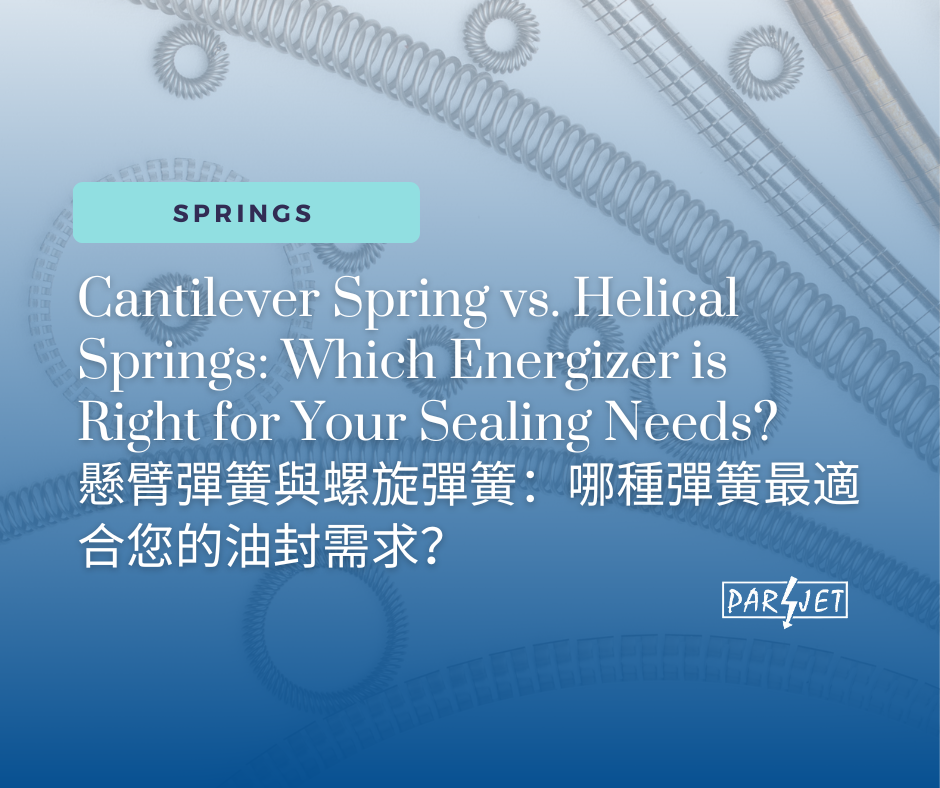
Cantilever Spring vs. Helical Springs: Which Energizer is Right for Your Sealing Needs?
Choosing the right spring for your application is the cornerstone of the optimal seal performance and longevity of your sealing systems. We will explore the characteristics and advantages of cantilever and helical springs to help you make an informed decision for your advanced sealing needs.
Understanding Cantilever Springs
HiPerSeal® with Cantilever Spring
Features:
- • Moderate Spring Rate: The V-shaped design provides a balanced load versus deflection ratio, making it suitable for various applications.
- • Precision Loading: The long beam leg ensures that the spring load is applied precisely at the leading edge of the PTFE seal.
- • Easy Integration: Can replace standard inch fractional and AS 568A O-rings without any modifications.
- • Material Options: Typically made of austenitic series stainless steel, with options like Hastelloy® and Elgiloy® for enhanced corrosion resistance.
- • Temperature Range: Effective operation between -150°C and 260°C.
- • Optional Scraper Lip Design: Available for use in abrasive media or harsh environments.
Recommended Applications:
• Reciprocating Rod and Piston Seals: Ideal for dynamic sealing applications.
• Rotating Shafts: Suitable for speeds up to 4 m/s.
• Wide Tolerance and Misaligned Glands: Effective in static applications where gland tolerances may vary.
• Face Seals: Performs well in both internal and external pressure environments.
• High-Temperature Dynamics: Reliable in dynamic applications up to 260°C.
Cantilever springs are particularly advantageous in applications requiring precise loading and effective sealing under moderate pressure conditions.
Exploring Helical Springs
HiPerSeal® with Helical Spring
Features:
- • High Spring Rate: Designed for medium to heavy load applications, ensuring robust sealing performance.
- • Even Load Distribution: The helical design ensures uniform load across each band of the spring.
- • Easy Integration: Compatible with standard inch fractional and AS 568A O-rings without modifications.
- • Material Options: Made from stainless steel, with Elgiloy® and Hastelloy® options for environments requiring high corrosion resistance.
- • Temperature Range: Operates efficiently from -150°C to 300°C.
- • Limitations: Not suitable for applications with wide gland tolerances or significant misalignment.
Recommended Applications:
• Face Seals: Effective for both internal and external pressure environments.
• Static Rod and Piston Seals: Ideal for non-dynamic sealing applications.
• Slow Dynamic Seals: Suitable for applications with very slow movements.
• Vacuum and Cryogenic Sealing: Excels in environments requiring high vacuum or cryogenic temperatures.
Helical springs are preferred for their high load capacity and even load distribution, making them suitable for static sealing and high-load applications.
Cantilever vs. Helical Springs: A Comparison
Key Differences:
- • Spring Rate: Cantilever springs offer a moderate spring rate, making them suitable for dynamic applications, while helical springs provide a high spring rate for static and heavy load applications.
- • Load Distribution: Cantilever springs focus the load at the leading edge of the seal, whereas helical springs distribute the load evenly across the entire band.
- • Tolerance and Misalignment: Cantilever springs perform well in applications with wide tolerance and misalignment, unlike helical springs which require precise alignment.
- • Temperature Range: Both springs operate in similar temperature ranges, but helical springs can handle slightly higher maximum temperatures.
Choosing the Right Spring:
- • Dynamic vs. Static Applications: For dynamic applications involving reciprocating or rotating movements, cantilever springs are ideal. For static applications with high loads, helical springs are more suitable.
- • Load Requirements: Evaluate the load requirements of your application. Cantilever springs are better for moderate loads, while helical springs excel under heavy loads.
- • Environmental Conditions: Consider the environmental conditions, including temperature and exposure to corrosive substances. Helical springs offer more options for high-temperature and corrosive environments.
The Role of Canted Coil Springs
While cantilever and helical springs are widely used, canted coil springs also offer unique advantages, particularly in applications requiring consistent contact and low friction. Their unique design allows for multiple points of contact, making them suitable for friction-sensitive applications and providing excellent EMI/RFI shielding capabilities.
Features of Canted Coil Springs:
- • Flat Spring Rate: Provides a very flat load vs. deflection curve, available in several different spring loads.
- • Material Options: Standard 302 series stainless steel, with options for Hastelloy® and other materials upon request.
- • Versatile Applications: Suitable for reciprocating rod and piston seals, rotary shafts, and applications with wide tolerance and misaligned glands.
Conclusion
Understanding the distinct characteristics of cantilever, helical, and canted coil springs is essential for selecting the right spring for your sealing needs. Cantilever springs are optimal for dynamic applications requiring precise loading, while helical springs are better suited for static and high-load applications with uniform load distribution. Canted coil springs offer additional benefits for friction-sensitive and EMI/RFI shielding applications.
At Parjet, we specialize in providing customized spring solutions tailored to your specific requirements. With our expertise and a wide range of material options, we ensure that your springs perform optimally in any application. Contact us today to discuss your spring needs and discover how we can assist you in selecting the perfect spring energizers for your application.





